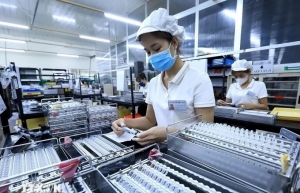Vietnam’s foreign investment landscape in 2024 and beyond
In the first eight months of 2024, disbursed foreign direct investment (FDI) increased 8 per cent on-year to $14 billion, or 5 per cent of GDP. FDI inflows also equated to 5 per cent/GDP last year, and we expect another 5 per cent/GDP worth of inflows again next year. To put those figures in context, China’s FDI inflows peaked at around 5 per cent/GDP, so Vietnam is regularly attracting FDI inflows equivalent to those China attracted in its heyday.
 |
| Michael Kokalari, chief economist, VinaCapital |
Vietnam remains a major magnet for FDI investment because the fact that multinational firms are impressed by the quality of the country’s workers – with factory wages in Vietnam less than half those in China, and Vietnam’s “bamboo diplomacy” strategy ensures that multinational firms that set up factories in Vietnam can readily source critical components they need to produce their products from China, and then export their finished products to the US and the EU without worrying whether those exports could attract steep tariffs.
Vietnam has a circa 20 per cent/GDP trade surplus with the US - its biggest export market - and a 15 per cent/GDP trade deficit with China - the biggest supplier to Vietnam’s factories. The country has enjoyed healthy trade surpluses with the US, and the country’s reliance on China for one-third of its production inputs has generated persistent trade deficits with China.
However, the gap became bigger in recent years because most of the FDI Vietnam is now attracting is from companies that moved production from China or are establishing new production facilities in Vietnam instead of in China.
There have been some concerns that India could emerge as a major competitor to Vietnam for FDI. Those concerns intensified after Apple’s Tim Cook visited India early last year and announced significant investments into that country. However, most FDI into India is focused on the production of products sold into the local market and not for export to the world. In Apple’s case, India does not produce enough iPhones to satisfy demand from the fast-growing local market, even after additional investments into India by Apple and its suppliers.
Furthermore, it is unlikely that India will become an export powerhouse like Vietnam anytime soon because manufacturers in India face many more “ease of doing business” obstacles there than they would in Vietnam, including much stricter labour laws that make it difficult for companies to hire-and-fire workers. The Indian government has made some efforts to boost the country’s manufacturing sector and to engage more FDI over the years, but those efforts have not been very successful.
Indonesia is another country we are occasionally asked about regarding FDI and whether it poses a threat to Vietnam. In short, we do not believe it does. The recent boom in FDI into Indonesia stems from the fact that the country’s government clamped down on companies exporting some raw minerals (such as nickel), and instead started forcing multinational companies to invest in processing/smelting facilities in Indonesia.
The fact that Indonesia passed those laws requiring local processing of minerals, together with a surge in demand for electric vehicle battery metals, explains why there has been a mini boom of FDI inflows to Indonesia recently. Many analysts now say that Indonesia is the Saudi Arabia of e-vehicle metals because the country has so many minerals that are needed for this area.
Analysing the pros and cons of potential competitors to Vietnam for foreign direct investments leads us to the conclusion that there are few countries in the world that are as suitable as Vietnam to manufacture the types of products foreign companies make here, such as high-tech products, smartphones, consumer electronics, and other products that are assembled in Vietnam.
Consequently, we expect investments to continue to flow into the production of such products in Vietnam for years to come, irrespective of whether Vietnam’s government actively courts multinational investors, since Vietnam is intrinsically appealing to them.
All of that said, there are many policies Vietnam’s government could pursue to make the country even more appealing to foreign investors.
For example, Vietnam’s direct power purchase mechanism will encourage FDI because companies are increasingly cognisant of their carbon footprints, and the mechanism enables manufacturers to source electricity from specific wind farms, solar electric generating facilities, and other sources of clean energy.
Vietnam’s government could also improve the country’s ease of doing business rankings by cutting the administrative burdens entailed in investing in the country. For example, in the past, VinaCapital has advocated that Vietnam set up an investment promotion agency, which is a similar strategy used by several other countries that Vietnam is competing against to entice FDI inflows.
Such an agency could be a single point of contact for foreign multinational companies and could itself then interface with all the other government agencies and bodies (including local/provincial governments) entailed in setting up a new factory in Vietnam – including obtaining the necessary business licences, handling procedures for employing foreign managers, etc.
Finally, it is also important that the government continue spending 5-6 per cent of GDP on infrastructure spending in the years ahead to maintain Vietnam’s competitiveness going forward. To be clear, we do not believe Vietnam’s infrastructure is currently a binding constraint preventing any companies from setting up factories, but it could become a consideration at some point, especially if the government does not continue to boost electricity generation and distribution capacity in Vietnam.
 | Vietnam reports $20.5 billion in FDI in first eight months More than $20.52 billion in foreign direct investment (FDI) has been reported in Vietnam up to the end of August, an on-year increase of 7 per cent, according to the Foreign Investment Agency. |
 | Vietnam sustaining growth amidst shifting FDI trends Trade ties between the US and emerging market economies in the Asia-Pacific region are shifting from efforts to diversify supply chains out of China through “friendshoring” or “nearshoring”. Against this backdrop, Vietnam is among the Asia-Pacific markets relatively well-placed to gain from such shifts. |
 | UOB forecasts Vietnam's economic growth to continue, boosted by trade and FDI Vietnam's economy is expected to maintain strong growth throughout 2024, supported by rising trade activity and increasing foreign direct investment, while favourable demographics and solid macroeconomic fundamentals underpin its long-term prospects in ASEAN, according to UOB. |
 | FDI results in localities above expectations Many localities have reported a surge in foreign direct investment this year, and it looks as though they may surpass set targets. |
What the stars mean:
★ Poor ★ ★ Promising ★★★ Good ★★★★ Very good ★★★★★ Exceptional
 Tag:
Tag:
Related Contents
Latest News
More News
- Global partnerships key to Vietnam’s IFC development (December 26, 2025 | 16:18)
- Vingroup pulls out of bid to invest in North-South high-speed railway (December 26, 2025 | 11:42)
- Strengthening supply chains through trade promotions and customs reform (December 24, 2025 | 14:00)
- PM orders investment model for North–South high-speed rail (December 22, 2025 | 17:43)
- LS Eco Energy to invest in Vietnam rare earth sector (December 22, 2025 | 17:31)
- Government moves to establish International Financial Centre (December 21, 2025 | 21:00)
- Vietnam's IFC to target global investment flows (December 21, 2025 | 18:00)
- Two national hospitals expand capacity with new facilities (December 20, 2025 | 09:00)
- Ha Tinh breaks ground on major Vingroup industrial and energy projects (December 19, 2025 | 18:24)
- EVN launches major power infrastructure projects nationwide (December 19, 2025 | 18:17)






















 Mobile Version
Mobile Version